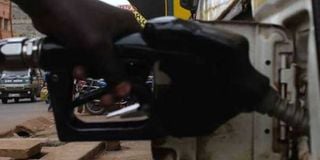Fuel VAT calls for dialogue on efficiency, equity of tax system

An attendant fills a tank at a fuel station in Nyeri on June 14, 2016. FILE PHOTO | JOSEPH KANYI |
What you need to know:
The greatest point of contention is that fuel VAT would have a transmission effect on all economic activities.
There’s a good reason why VAT on fuel makes great sense from a tax collector’s point of view.
The standoff between the government and taxpayers over the 16 per cent value added tax (VAT) on petroleum products since September 1 is a good opportunity for dialogue on collection and spending of taxes.
While the debate is heavily against the government’s intention to raise more revenue from taxes, the dialogue should be on whether the tax system is efficient, fair and equitable.
The greatest point of contention is that fuel VAT would have a transmission effect on all economic activities. Producers and transporters of goods and suppliers of services would pass it on to consumers, implying that there’s a strong possibility that prices would rise following the higher fuel costs.
HIGHER FUEL PRICES
A cost spiral triggered by higher fuel prices would be difficult to manage and could negatively affect the economy.
While government policy is focused on economic growth and job creation, dearer fuel would dampen economic growth prospects, cause inflation and constrain productive sectors from creating jobs.
From a planning perspective, the greater issue of concern should be how many individuals and firms pay taxes.
A good tax system should, ideally, have a wide base. The big question then is: How many people and firms are in the Kenya Revenue Authority (KRA) tax net and, more importantly, how many potential taxpayers are outside the bracket? The personal income tax base depends on how many pay tax on their incomes and file returns to the KRA. The estimate is just about three million — which would imply that only six per cent of Kenyans support the entire population of 49 million.
DEPENDENCY BURDEN
This is a huge dependency burden, and the risk to the government is that if the number of the few taxpayers goes down (by job losses when firms retrench or shut down, or by natural attrition), there would be a corresponding fall in tax revenue.
The same applies to corporate taxpayers. While it is easy for KRA to net large and medium-sized taxpayers, it is more difficult for the agency to track the large number of small- and medium-sized enterprises capable of paying taxes that haven’t been captured.
The second critical statistic is how much each of the categories of tax contributes to the total tax revenue.
The budget statement for 2018/2019 published by the National Treasury shows that the government hopes to raise more than Sh1.95 trillion from taxes and appropriations in aid to finance 76.6 per cent of its planned expenditure of Sh2.56 trillion.
FOREIGN DEBT
The difference is covered by grants of Sh48.5 billion and a deficit of Sh558.9 billion, to be financed through domestic and foreign debt.
The structure of the taxation shows that income tax is the most important source of tax revenue with a share of 43 per cent for the current fiscal year.
The second significant source of tax is VAT, expected to yield 23.9 per cent of the total revenue. Excise and import duties are expected to yield 11.3 per cent and 6.1 per cent, respectively. The balance would be derived from appropriations in aid and other taxes.
The interpretation of this is that the structure of the tax system is more weighted towards income tax, which is expected to finance a third of the national Budget.
The danger with this type of structure is that income tax is a direct levy on earnings by individuals and firms.
PAYING TAXES
Considering that there are fewer firms and individuals paying taxes than the optimal number, then the tax yield from this category is hostage to taxpayers continuing to earn an income.
If firms’ profits fall and the individual taxpayers earn less or lose their jobs, income tax would plummet and the government would be left struggling to finance the Budget. To that extent, income tax is not a particularly efficient and equitable form of tax.
Indirect taxes are more widely accepted globally as the most efficient and equitable forms of taxes. They are levied on consumption and the cost of administration is lower because they are mostly collected at source or points of sale.
ELIGIBLE GOODS
This makes VAT particularly attractive as it nets majority of consumers each time they buy eligible goods and services.
There’s a good reason why VAT on fuel makes great sense from a tax collector’s point of view. Ideally, higher tax on fuel should force users to buy less, but they don’t. Even as the noise on the VAT increased last week, motorists trooped to petrol stations to fill up their tanks — proving that fuel consumers aren’t particularly responsive to changes in cost.
Mr Warutere is a director of Mashariki Communications Ltd. [email protected].





